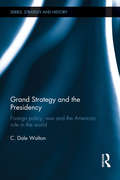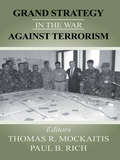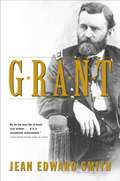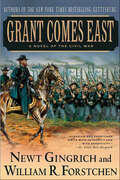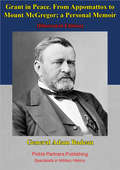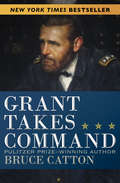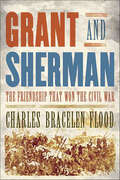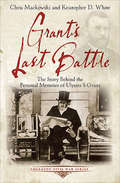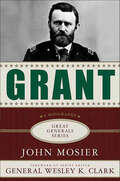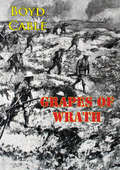- Table View
- List View
Grand Old Lady: Story Of The DC-3
by Lt.-Col. Wendell F. Moseley Lt.-Col. Carroll V. GlinesThis is a most excellent chronological history of the iconic DC-3 (Douglas Commercial aircraft, third model), also known as the C-47 (Cargo) in the US Army Air Forces and R4D in the US Navy, Good Old Gooney Bird, Dear old Dakota, and Grand Old Lady. She was noisy, drafty, easy to fly and utterly dependable. One thing Donald Douglas demanded was that she hold her altitude on one engine. She became the luxury airliner of the late 1930s and made air travel practicable. More than 11,000 DC-3s were built for the military during World War II, and several hundred are still flying. This book defines the versatility of this aircraft for delivering cargo of all kinds, dropping paratroopers, evacuating wounded, towing gliders (three at a time), and, with engines removed, being gliders, landing on studded snow tires, skis or pontoons as the mission required, then being reconverted to airline service after the war.--Print Ed.
Grand Strategy and Military Alliances
by Williamson Murray Peter R. Mansoor Mansoor, Peter R. and Murray, WilliamsonAlliances have shaped grand strategy and warfare since the dawn of civilization. Indeed, it is doubtful that the United States of America would have gained its independence without its Revolutionary War alliance with France. Such alliances may prove even more important to international security in the twenty-first century. Economic and financial difficulties alone will ensure that policy makers attempt to spread the burden of securing vital interests onto other nations through alliances, both formal organizations such as NATO and informal alliances of convenience as developed to wage the Gulf War in 1991. A team of leading historians examine the problems inherent in alliance politics and relationships in the framework of grand strategy through the lens of history. Aimed at not just the military aspects of alliances, the book uncovers the myriad factors that have made such coalitions succeed or fail in the past.
Grand Strategy and the Presidency: Foreign Policy, War and the American Role in the World (Strategy and History)
by C. Dale WaltonThis book examines the role and importance of the Presidency in the formulation and conduct of US grand strategy. The text discusses US strategic history, with particular emphasis on the period from the end of the Cold War to the present day. While the United States periodically has enjoyed exceptional presidential leadership in the past, this book argues that few future presidents will meet high standards of leadership in foreign affairs. In turn, this will undermine the ability of the United States to construct and maintain a coherent grand strategy appropriate to the multipolar world of the twenty-first century. Grand Strategy and the Presidency explores the role that the holders of the presidential office have played in the past development of the United States as a great power. Drawing upon examples from history, the textual analysis is shaped around the description of the long-term strategic development of the United States. The author then considers what the events of recent decades portend for the future of US strategy and foreign policy. This book will be of interest to students of Presidential Studies, US foreign policy, Strategic Studies, and IR/Security Studies in general.
Grand Strategy in the War Against Terrorism
by Paul B. Rich Thomas R. MockaitisThis collection of essays examines the strategic dimensions of contemporary terrorist threats. It evaluates the changing nature of modern terrorism in the light of the events of September 11 2001. The collection argues that terrorism now promises to enter the terrain of global "grand strategy".
Grandes batallas navales desconocidas (Historia Incógnita)
by Víctor San JuanDesde la Caída de Constantinopla y la Guerra de Flandes hasta la Segunda Guerra Mundial, conozca catorce desconocidas campañas navales de ámbito universal, que, a pesar de su trascendencia y marcar su época, suelen permanecer ignoradas o minusvaloradas. Un recorrido diferente por la historia naval, no a través de las clásicas batallas, sino de las otras que, por uno u otro motivo (investigación poco exhaustiva, pertenecer a períodos poco estudiados, ser extrañas en nuestro país o quedar ubicadas en épocas con otras más famosas) quedaron al margen, pero cuya relevancia se desvela sin más que repasar sus líneas. Antes del descubrimiento de América, resultan desconocidos los combates navales excluidos los de griegos y persas, cartagineses y romanos; el trabajo aporta los librados en la toma de Constantinopla (Estambul). Igualmente, es poco sabido que las guerras de Flandes tuvieron enfrentamientos navales como se desvela en el Puente de Farnesio. También que la suerte de Gibraltar se decidió en una batalla naval, o que el Brasil español del siglo XVII trajo un gran enfrentamiento entre galeones holandeses y españoles. Desconocidas son también batallas como Navarino o Lissa, imbricadas en el nacimiento de jóvenes naciones como las modernas Grecia e Italia. Remota parece la batalla del Yalú, decisiva para China y Japón, mientras que pocas veces se citan las victorias navales españolas de Cárdenas y Cienfuegos, durante el Desastre de 1898. La guerra ruso-japonesa de 1905 cuenta con una tercera batalla a añadir a las derrotas de mar Amarillo, Port Arthur y Tsushima, la de Ulsan a cargo de los legendarios cruceros de Vladivostok, casi nunca considerada. Introducidos ya en la Segunda Guerra Mundial, nos adentraremos en nuevas perspectivas desmitificadoras que se ofrecen de la conquista de Narvik durante la campaña de Noruega, el combate del Río de la Plata y la larga pugna en las batallas de Guadalcanal. Mientras que pocas veces se encuentra una completa reseña de una brillante victoria naval como la de la isla Savo (tal vez porque vencieron los japoneses) ni de las míticas y sacrificadas hazañas del Tokio Express. Todo ello contiene esta obra cuya pretensión es la aportación de nuevos datos, visiones y perspectivas que enriquezcan clásicos esquemas de la historia naval.
Grandes estrategias
by John Lewis GaddisUna clase magistral sobre el arte del liderazgo por el mayor experto mundial en pensamiento estratégico. ¿Qué lecciones de estrategia y liderazgo podemos extraer de la derrota de la Armada Invencible, de la actuación de Churchill en la Segunda Guerra Mundial o de las astutas decisiones de Pericles en la Grecia antigua? John Lewis Gaddis cuenta las más sorprendentes maniobras, fallidas o atinadas, desde el mundo clásico hasta la Segunda Guerra Mundial, y profundiza en el pensamiento estratégico a partir de figuras como Heródoto, César Augusto, San Agustín, Maquiavelo, Felipe II, Clausewitz, Tolstói, Lincoln, Roosevelt o Isaiah Berlin. Gaddis, distinguido historiador de la Guerra Fría, ha estado durante casi dos décadas al frente del legendario programa de estrategia de la Universidad de Yale. En Grandes estrategias reflexiona sobre todo lo aprendido y aplica sus profundos conocimientos para conectar momentos, lugares y personas como nunca antes se había hecho. Para cualquier persona interesada en el arte de la estrategia en cualquier terreno, este libro es una clase magistral. La crítica ha dicho...«Una valiosa defensa de las artes liberales, una reflexión atractiva sobre la educación universitaria y algún consejo oportuno sobre cómo la victoria duradera consiste en ganar lo que puedas en lugar de todo lo que deseas.»Victor Davis Hanson, The New York Times «Brillante, sabio, escrito de manera seductora y profundo.»Roger Kimball, The New Criterion «Gaddis se ha ganado el derecho indiscutible a arar en diferentes campos de investigación histórica, cosa que hace aquí con evidente deleite y curiosidad peripatética.»Gordon M. Goldstein, The Washington Post «Un largo paseo en compañía de una mente única y encantadora, que logra transmitir las lecciones extraídas de distintos continentes y milenios.»John Nagl, The Wall Street Journal «Todo lo que hay que saber sobre cómo los líderes toman decisiones estratégicas. Un estudio sabio e ingenioso del pasado al servicio del futuro.»Kirkus Reviews «Gaddis muestra un profundo conocimiento de la historia y ofrece un estilo de prosa agradablemente sintético a este riguroso estudio del liderazgo.»Publishers Weekly
Grandpa Stops a War: A Paul Robeson Story
by Susan Robeson"It takes a man of peace to stop a war." The true story of Paul Robeson's visit to the front lines of the Spanish Civil War is a tale of courage and activism told by his granddaughter, Susan Robeson. Grandpa Paul was a world-famous actor and singer with a deep and rumbling voice, a man of peace and principle who worried about the safety of children and families living in countries at war. He wanted to use his voice to promote social justice all over the world. Though people warned Grandpa Paul that it was too dangerous, he traveled with his friend Captain Fernando to the battlefields of the Spanish Civil War to sing to the soldiers. And then something amazing happened...With gorgeous illustrations from fine artist Rod Brown, Grandpa Stops a War celebrates Paul Robeson's global activism and towering achievements, and shows readers the power of music in times of discord and war.An author's note helps readers learn more about the author's personal experience growing up in the Robeson family, and gives parents, teachers, and librarians more in-depth material to expand the reader's understanding of the war and Robeson as a champion of civil rights, global freedom, and world peace.
Grandpa Was a Whaler: A Story of Carteret Chadwicks
by Amy MuseA survey of the Chadwick family of the Northeast and North Carolina, who played a pivotal role in the development of the regional commerce. The narrative focuses on the period from around 1725 and just after the Civil War.Researcher Amy Muse, a direct descendant of the Chadwicks on her mother’s side, first published Grandpa Was a Whaler in 1961. It became the first thorough research document on the earliest history of whaling in America in 1681 and the involvement of the Chadwick family over the years in whaling and ocean-going shipping. The narrative focuses on the period from around 1725 and just after the Civil War, from Massachusetts to North Carolina and, in particular, to Carteret County, North Carolina, where the Chadwicks established residency.
Grano e non zizzania: Onore a un Maresciallo
by Guido Galeano VegaDescrizione del libro: In Grano e Non Zizzania si potrà vedere che, nonostante i progressi della scienza e della tecnologia, e nonostante tutte le esperienze riportate, l'umanità si sta muovendo verso la ripetizione di vecchi errori. Si potrà capire chiaramente che la maledizione del peccato, del male e della violenza è ancora insita nella genetica umana e, in un certo senso, le Sacre Scritture hanno di nuovo ragione. Il desiderio dello scrittore di Grano e Non Zizzania è di motivare a rafforzare i valori nobili nella vita della società umana, perché è una lotta di ciascuno, scegliere tra il bene e il male, non solo per ogni comune cittadino, ma anche per coloro che hanno la dura responsabilità della guida di nazioni, etnie e popoli. C'è una vecchia storia, in cui si racconta che viene chiesto ad un anziano il perché del bene e del male nelle persone. Il vecchio gli spiega che all'interno dell'essere umano ci sono due lupi, uno è un lupo buono e l'altro è un lupo cattivo, e sopravvive e diventa forte quello che viene nutrito, e muore quello che viene lasciato indifeso ed abbandonato. Se le nazioni continuano a fabbricare bombe nucleari ed investono milioni di dollari in materiale bellico, il lupo cattivo sta trionfando di nuovo nel mondo. Se ci lamentiamo del mondo in cui viviamo, non è perché il mondo sia cattivo, ma perché le persone non vogliono essere buone. Ognuno è responsabile per il miglioramento. La violenza non è una soluzione, è solo una scusa per coloro che servono e amano la violenza ed alimentano le loro priorità coi benefici che ne derivano. Siamo tutti chiamati da Dio ad essere grano e non zizzania. parole chiave: Alleanza, Grande Guerra, Triplice Alleanza, Guerra del Paraguay, Maresciallo Lopez, Grano, Zizzania, Difesa
Grant
by Jean Edward SmithUlysses S. Grant was the first four-star general in the history of the United States Army and the only president between Andrew Jackson and Woodrow Wilson to serve eight consecutive years in the White House. As general in chief, Grant revolutionized modern warfare. Rather than capture enemy territory or march on Southern cities, he concentrated on engaging and defeating the Confederate armies in the field, and he pursued that strategy relentlessly. As president, he brought stability to the country after years of war and upheaval. He tried to carry out the policies of Abraham Lincoln, the man he admired above all others, and to a considerable degree he succeeded. Yet today, Grant is remembered as a brilliant general but a failed president. In this comprehensive biography, Jean Edward Smith reconciles these conflicting assessments of Grant's life. He argues convincingly that Grant is greatly underrated as a president. Following the turmoil of Andrew Johnson's administration, Grant guided the nation through the post- Civil War era, overseeing Reconstruction of the South and enforcing the freedoms of new African-American citizens. His presidential accomplishments were as considerable as his military victories, says Smith, for the same strength of character that made him successful on the battlefield also characterized his years in the White House. Grant was the most unlikely of military heroes: a great soldier who disliked the army and longed for a civilian career. After graduating from West Point, he served with distinction in the Mexican War. Following the war he grew stale on frontier garrison postings, despaired for his absent wife and children, and began drinking heavily. He resigned from the army in 1854, failed at farming and other business endeavors, and was working as a clerk in the family leathergoods store when the Civil War began. Denied a place in the regular army, he was commissioned a colonel of volunteers and, as victory followed victory, moved steadily up the Union chain of command. Lincoln saw in Grant the general he had been looking for, and in the spring of 1864 the president brought him east to take command of all the Union armies. Smith dispels the myth that Grant was a brutal general who willingly sacrificed his soldiers, pointing out that Grant's casualty ratio was consistently lower than Lee's. At the end of the war, Grant's generous terms to the Confederates at Appomattox foreshadowed his generosity to the South as president. But, as Smith notes, Grant also had his weaknesses. He was too trusting of his friends, some of whom schemed to profit through their association with him. Though Grant himself always acted honorably, his presidential administration was rocked by scandals. "He was the steadfast center about and on which everything else turned," Philip Sheridan wrote, and others who served under Grant felt the same way. It was this aura of stability and integrity that allowed Grant as president to override a growing sectionalism and to navigate such national crises as the Panic of 1873 and the disputed Hayes-Tilden election of 1876. At the end of his life, dying of cancer, Grant composed his memoirs, which are still regarded by historians as perhaps the finest military memoirs ever written. They sold phenomenally well, and Grant the failed businessman left his widow a fortune in royalties from sales of the book. His funeral procession through the streets of Manhattan closed the city, and behind his pallbearers, who included both Confederate and Union generals, marched thousands of veterans from both sides of the war.
Grant Comes East: A Novel of the Civil War (The Gettysburg Trilogy #2)
by Newt Gingrich William R. ForstchenThe New York Times–bestselling authors of Gettysburg continue their “original, dramatic and historically plausible ‘what if?’ story” of the Civil War (Publishers Weekly).Confederate General Robert E. Lee knows that a frontal assault against Washington, D.C., could devastate his army. But it is a price that must be paid for final victory. Lee must also overcome the defiant stand of President Abraham Lincoln, who vows that regardless of the defeat at Gettysburg, his solemn pledge to preserve the Union will be honored. Lincoln will mobilize the garrison of Washington to hold on no matter the cost.Meanwhile, Lincoln has appointed General Ulysses S. Grant as commander of all Union forces. Fresh from his triumph at Vicksburg, Grant races east to confront Lee. What ensues is a titanic struggle as the surviving Union forces inside the fortifications of Washington fight to hang on, while Grant prepares his counterblow.The defeated Army of the Potomac, staggered by the debacle dealt at Gettysburg, is not yet completely out of the fight, and is slowly reorganizing. Its rogue commander, General Dan Sickles, is thirsting for revenge against Lee, the restoration of his army’s honor, and the fulfillment of his own ambitions, which reach all the way to the White House. All these factors will come together in a climatic struggle spanning the ground from Washington, through Baltimore, to the banks of the Susquehanna River.
Grant In Peace. From Appomattox To Mount Mcgregor; A Personal Memoir
by General Adam BadeauFew men can have known General and President of the United States Ulysses S. Grant as well as General Adam Badeau. As Grant's military secretary during 1864-1865, he came to know and work closely with the future president; after the war he would go on to write a three volume history of Grant's military campaigns and serve as senior research assistant to Grant when the later was writing his memoirs. General Badeau came to recognize Grant's capabilities of healing a divided nation and was a frequent correspondent and eventually the President's confidant. General Badeau would go on to write of his friend's history in both his military and peacetime periods with great success. In this volume, Badeau charts Grant's political career and his manoeuvring that led to his appointment as President.
Grant Moves South: Grant Moves South And Grant Takes Command
by Bruce CattonA Pulitzer Prize-winning historian's acclaimed Civil War history of the complex man and controversial Union commander whose battlefield brilliance ensured the downfall of the Confederacy Preeminent Civil War historian Bruce Catton narrows his focus on commander Ulysses S. Grant, whose bold tactics and relentless dedication to the Union ultimately ensured a Northern victory in the nation's bloodiest conflict. While a succession of Union generals--from McClellan to Burnside to Hooker to Meade--were losing battles and sacrificing troops due to ego, egregious errors, and incompetence, an unassuming Federal Army commander was excelling in the Western theater of operations. Though unskilled in military power politics and disregarded by his peers, Colonel Grant, commander of the Twenty-First Illinois Volunteer Infantry, was proving to be an unstoppable force. He won victory after victory at Belmont, Fort Henry, and Fort Donelson, while brilliantly avoiding near-catastrophe and ultimately triumphing at Shiloh. And Grant's bold maneuvers at Vicksburg would cost the Confederacy its invaluable lifeline: the Mississippi River. But destiny and President Lincoln had even loftier plans for Grant, placing nothing less than the future of an entire nation in the capable hands of the North's most valuable military leader. Based in large part on military communiqués, personal eyewitness accounts, and Grant's own writings, Catton's extraordinary history offers readers an insightful look at arguably the most innovative Civil War battlefield strategist, unmatched by even the South's legendary Robert E. Lee.
Grant Takes Command: Grant Moves South And Grant Takes Command
by Bruce CattonA thrilling account of the final years of the War Between the States and the great general who led the Union to victory This conclusion of Pulitzer Prize-winning author Bruce Catton's acclaimed Civil War history of General Ulysses S. Grant begins in the summer of 1863. After Grant's bold and decisive triumph over the Confederate Army at Vicksburg--a victory that wrested control of the Mississippi River from Southern hands--President Abraham Lincoln promoted Grant to the head of the Army of the Potomac. The newly named general was virtually unknown to the nation and to the Union's military high command, but he proved himself in the brutal closing year and a half of the War Between the States. Grant's strategic brilliance and unshakeable tenacity crushed the Confederacy in the battles of the Overland Campaign in Virginia and the Siege of Petersburg. In the spring of 1865, Grant finally forced Robert E. Lee's surrender at Appomattox Court House, thus ending the bloodiest conflict on American soil. Although tragedy struck only days later when Lincoln--whom Grant called "incontestably the greatest man I have ever known"--was assassinated, Grant's military triumphs would ensure that the president's principles of unity and freedom would endure. In Grant Takes Command, Catton offers readers an in-depth portrait of an extraordinary warrior and unparalleled military strategist whose brilliant battlefield leadership saved an endangered Union.
Grant and His Generals
by Clarence Edward Noble MacartneyBased on 40 years of research on the Civil War, this book portrays little-known, but dramatic events incident to General Ulysses Grant's leadership of the Union armies.Grant’s Civil War career is a bright parenthesis in a long paragraph of failure. He failed as an officer in the old army; not indeed in the Mexican War itself, but thereafter, when he left the army under a cloud. He failed as a farmer; as a real-estate agent; in the opinion of many, as a President; and as a banker. But from Belmont to Appomattox, meeting and defeating one after another the ablest generals the South could pit against him, from Albert Sidney Johnston to Robert E. Lee, he enjoyed an unbroken record of victory and success.That success has puzzled many a student. How shall we account for it? Badeau, Grant’s military secretary, said that neither he nor the other members of the staff knew why Grant succeeded. They believed in him “because of his success.” Perhaps Sherman approached as nearly as anyone the secret; writing to Grant after he had been appointed lieutenant-general and commander of all the armies, he said: “The chief characteristic of your nature is the simple faith in success you have always manifested, which I can liken to nothing else than the faith a Christian has in his Saviour.”A great personality always embodies intangibles which elude classification and baffle definition. Undoubtedly, one of the best ways to study Grant and penetrate to the heart and mind of this in many ways inscrutable character is to regard him in the light of his personal and military association with the leading officers who labored with him.
Grant and Lee: A Study in Personality and Generalship [Second Edition]
by Maj.-Gen J. F. C. FullerFirst published in 1957, this second edition of the analysis of the generalship of Ulysses S. Grant and Robert E. Lee remains one of the most readable histories of the Civil War. The author began his research sharing the generally held assumption that Lee was a great general and Grant a clumsy “butcher.” By the time Fuller completed his project, however, he regarded Grant as the greatest general of his age and one of the greatest strategists of any age. Grant and Lee is a compelling study not only of two remarkable men but also of the nature of leadership and command in wartime.“...cuts squarely across the accepted tradition...[Fuller] examines these two great soldiers from a fresh viewpoint and refuses to let himself be bound by tradition.”—Bruce Catton, New York Times Book Review“...a stimulating study which appreciates both the unique personalities of the protagonists and the social conditions which stamped their tactics.”—Commonweal“Fuller’s...analysis and comparison of the personality, leadership, and generalship of Grant and Lee is as readable, instructive, stimulating, and...controversial as when first published.”—Military Review
Grant and Sherman: The Friendship That Won the Civil War
by Charles Bracelen FloodThis dual Civil War biography presents “[a] powerful and illuminating study of a military collaboration that won the war for the Union” (Josiah Bunting III, Washington Post).“We were as brothers,” William Tecumseh Sherman said, describing his relationship to Ulysses S. Grant. They were incontestably two of the most important figures in the Civil War, but until now there has been no book about their victorious partnership and the deep friendship that made it possible.They were prewar failures: Grant was forced to resign from the Regular Army because of his drinking, and Sherman had moved from one job to the next in the years before the conflict. But heeding the call to save the Union, each struggled past political hurdles to join the war effort. And after taking each other’s measure at the Battle of Shiloh, they began their unique collaboration.Often together under fire on the war’s great battlefields, they also supported each other in the face of mudslinging criticism by the press and politicians. Sharing the demands of family life and the heartache of loss, they built a mutual admiration and trust which President Lincoln increasingly relied upon. Though their headquarters were hundreds of miles apart, they communicated almost daily, strategizing the final moves of the war and planning how to win the peace that would follow.
Grant's Emergence As A Strategic Leader July, 1863, To March, 1864
by LTC Robert L. BallThis paper looks at Ulysses S. Grant's development as a strategic leader with emphasis on the time period July, 1863, to March, 1864. It has a dual focus. The first is an examination of Grant's growth as a strategic thinker. The second is on the opening of opportunity for Grant to become a leader at the strategic level. The paper is written chronologically, with both subjects interwoven.Bruce Catton, Lloyd Lewis, Carl Sandburg, and T. Harry Williams wrote the primary sources used in research and provided a good balance of "Grant-centric" and "Lincoln-centric" views. Whenever possible, The Official Records of the Rebellion were used. Care was taken to use source material written during the Civil War. Sherman's war time views of Grant's abilities carry more weight in this paper than what he wrote after the war. Similarly, Grant's Memoirs were read with a jaundiced eye.The findings of the research are laid out in the body of the paper. Grant's career is reviewed in order to show a steady progression of ability. There is also a noticeable maturation in Grant's strategic thinking that can be seen in the period highlighted. Finally, incidents are examined in which Grant proved himself to President Lincoln to be a perceptive, adept actor in the politics of high level command, earning Lincoln's trust and confidence.The conclusion of the paper is that just when the nation called for him, Grant had developed the essential skills for the job of general-in-chief.
Grant's Last Battle: The Story Behind the Personal Memoirs of Ulysses S. Grant (Emerging Civil War Series)
by Chris Mackowski Kristopher D. WhiteThe remarkable story of how one of America’s greatest military heroes became a literary legend. The former general in chief of the Union armies during the Civil War . . . the two-term president of the United States . . . the beloved ambassador of American goodwill around the globe . . . the respected New York financier—Ulysses S. Grant—was dying. The hardscrabble man who regularly smoked twenty cigars a day had developed terminal throat cancer. Thus began Grant’s final battle—a race against his own failing health to complete his personal memoirs in an attempt to secure his family’s financial security. But the project evolved into something far more: an effort to secure the very meaning of the Civil War itself and how it would be remembered. In this maelstrom of woe, Grant refused to surrender. Putting pen to paper, the hero of Appomattox embarked on his final campaign: an effort to write his memoirs before he died. The Personal Memoirs of Ulysses S. Grant would cement his place as not only one of America’s greatest heroes but also as one of its most sublime literary voices. Authors Chris Mackowski and Kristopher D. White have recounted Grant’s battlefield exploits as historians at Fredericksburg and Spotsylvania National Military Park, and Mackowski, as an academic, has studied Grant’s literary career. Their familiarity with the former president as a general and as a writer bring Grant’s Last Battle to life with new insight, told with the engaging prose that has become the hallmark of the Emerging Civil War Series.
Grant: A Biography (Great Generals Series)
by John MosierGrant: A Biography tells of the extraordinary life and legacy of one of America's most ingenious military mindsA modest and unassuming man, Grant never lost a battle, leading the Union to victory over the Confederacy during the Civil War, ultimately becoming President of the reunited states. Grant revolutionized military warfare by creating new leadership tactics by integrating new technologies in classical military strategy. In this compelling biography, John Mosier reveals the man behind the military legend, showing how Grant's creativity and genius off the battlefield shaped him into one of our nation's greatest military leaders.
Grant: The Wartime Letters Of Ulysses S. Grant To His Wife
by Ron Chernow<P>Pulitzer Prize winner Ron Chernow returns with a sweeping and dramatic portrait of one of our most compelling generals and presidents, Ulysses S. Grant. <P>Ulysses S. Grant's life has typically been misunderstood. All too often he is caricatured as a chronic loser and an inept businessman, or as the triumphant but brutal Union general of the Civil War. But these stereotypes don't come close to capturing him, as Chernow shows in his masterful biography, the first to provide a complete understanding of the general and president whose fortunes rose and fell with dizzying speed and frequency. Before the Civil War, Grant was flailing. <P>His business ventures had ended dismally, and despite distinguished service in the Mexican War he ended up resigning from the army in disgrace amid recurring accusations of drunkenness. But in war, Grant began to realize his remarkable potential, soaring through the ranks of the Union army, prevailing at the battle of Shiloh and in the Vicksburg campaign, and ultimately defeating the legendary Confederate general Robert E. Lee. Along the way, Grant endeared himself to President Lincoln and became his most trusted general and the strategic genius of the war effort. Grant’s military fame translated into a two-term presidency, but one plagued by corruption scandals involving his closest staff members. <P>More important, he sought freedom and justice for black Americans, working to crush the Ku Klux Klan and earning the admiration of Frederick Douglass, who called him “the vigilant, firm, impartial, and wise protector of my race.” After his presidency, he was again brought low by a dashing young swindler on Wall Street, only to resuscitate his image by working with Mark Twain to publish his memoirs, which are recognized as a masterpiece of the genre. <P> With lucidity, breadth, and meticulousness, Chernow finds the threads that bind these disparate stories together, shedding new light on the man whom Walt Whitman described as “nothing heroic... and yet the greatest hero.” Chernow’s probing portrait of Grant's lifelong struggle with alcoholism transforms our understanding of the man at the deepest level. This is America's greatest biographer, bringing movingly to life one of our finest but most underappreciated presidents. The definitive biography, <i>Grant</i> is a grand synthesis of painstaking research and literary brilliance that makes sense of all sides of Grant's life, explaining how this simple Midwesterner could at once be so ordinary and so extraordinary. <P><b>A New York Times Bestseller</b>
Grant’s Campaign in Virginia (Special Campaigns Series #8)
by Captain Vaughan-SawyerThis ebook is purpose built and is proof-read and re-type set from the original to provide an outstanding experience of reflowing text for an ebook reader. Includes Civil War Map and Illustrations Pack - 224 battle plans, campaign maps, and detailed analyses of actions spanning the entire period of hostilities. The high-tide of Confederate success had passed with Pickett's charge at the battle of Gettysburg; the Union armies were re-invigorated by fresh leadership under Lieut.-General U.S. Grant, who decided upon a campaign that was to push toward the Confederate capital of Virginia through Spotsylvania. The area over which Grant intended to advance was sparsely populated, inaccessible and densely wooded, and his troops' numerical superiority could only be used in the few open areas for a general action. Grant knew that his troops would have to move in separate columns, if only to concentrate for concerted action. General Lee moved to attack the Union troops as they moved into position, before the numerical advantage in open country would spell doom to Confederate hopes. The fighting was confused and bloody; but despite the losses of the Union army, which exceeded the losses of the Confederates greatly, Grant ground onward for he knew that he could afford the casualties better than his enemy. This book is part of the Special Campaigns series produced around the turn of the 20th century by serving or recently retired British and Indian Army officers. They were intended principally for use by British officers seeking a wider knowledge of military history. Captain Vaughan-Sawyer served in the Indian army for all his adult life before falling in the opening months of the First World War. His excellent book is evidence of a life cut short. Title - Grant's Campaign in Virginia (The Wilderness Campaign) 1864 Author -- Captain Vaughan-Sawyer (1875-1914) Series Name - Special Campaigns Series Series Number --8 Text taken, whole and complete, from the edition published in 1908, London, by Swan Sonnenschein & Co. Original -197 pages. Illustrations -- The maps cannot be reproduced with this volume as they are A3 - 224 additional maps have been added.
Grant’s Left Hook: The Bermuda Hundred Campaign, May 5–June 7, 1864 (Emerging Civil War Series)
by Sean ChickRobert E. Lee feared the day the Union army would return up the James River and invest the Confederate capital of Richmond. In the spring of 1864, Ulysses Grant, looking for a way to weaken Lee, was about to exploit the Confederate commander’s greatest fear and weakness. After two years of futile offensives in Virginia, the Union commander set the stage for a campaign that could decide the war. Grant sent the 38,000-man Army of The James to Bermuda Hundred, to threaten and possibly take Richmond, or at least pin down troops that could reinforce Lee. Jefferson Davis, in desperate need of a capable commander, turned to the Confederacy’s first hero: Pierre Gustave Toutant Beauregard. Butler’s 1862 occupation of New Orleans had infuriated the South, but no one more than Beauregard, a New Orleans native. This campaign would be personal. In the hot weeks of May 1864, Butler and Beauregard fought a series of skirmishes and battles to decide the fate of Richmond and Lee’s army. Historian Sean Michael Chick analyzes and explains the plans, events, and repercussions of the Bermuda Hundred Campaign in Grant’s Left Hook: The Bermuda Hundred Campaign, May 5-June 7, 1864. The book contains hundreds of photographs, new maps, and a fresh consideration of Grant’s Virginia strategy and the generalship of Butler and Beauregard. The book is also filled with anecdotes and impressions from the rank and file who wore blue and gray.
Grape And Canister: The Story Of The Field Artillery Of The Army Of The Potomac, 1861 To 1865
by L. Vanloan NaisawaldIncludes - 18 maps and 6 illustrations"The role of the field artillery in the Civil War is often overlooked in favor of the more romantic views of great cavalry commanders or infantrymen. But the reality was that without the field artillery, many of the decisive battles won by the Army of the Potomac most likely would have resulted in defeat and/or destruction. Grape and Canister, first published in 1960, has since become a classic and remains the definitive study of the field artillery of the Army of the Potomac."-Print ed.
Grapes Of Wrath
by Boyd CableIT is possible that this book may be taken for an actual account of the Somme battle, but I warn readers that although it is in the bulk based on the fighting there and is no doubt colored by the fact that the greater part of it was written in the Somme area or between visits to it, I make no claim for it as history or as an historical account. My ambition was the much lesser one of describing as well as I could what a Big Push is like from the point of view of an ordinary average infantry private, of showing how much he sees and knows and suffers in a, great battle, of giving a glimpse perhaps of the spirit that animates the New Armies, the endurance that has made them more than a match for the Germans, the acceptance of appalling and impossible horrors as the work-a-day business and routine of battle, the discipline and training that has fused such a mixture of material into tempered fighting metal.For the tale itself, I have tried to put into words merely the sort of story that might and could be told by thousands of our men to-day. I hope, in fact, I have so "told the tale" that such men as I have written of may be able to put this book in your hands and say: "This chapter just describes our crossing the open," or "That is how we were shelled," or "I felt the same about my Blighty one."


